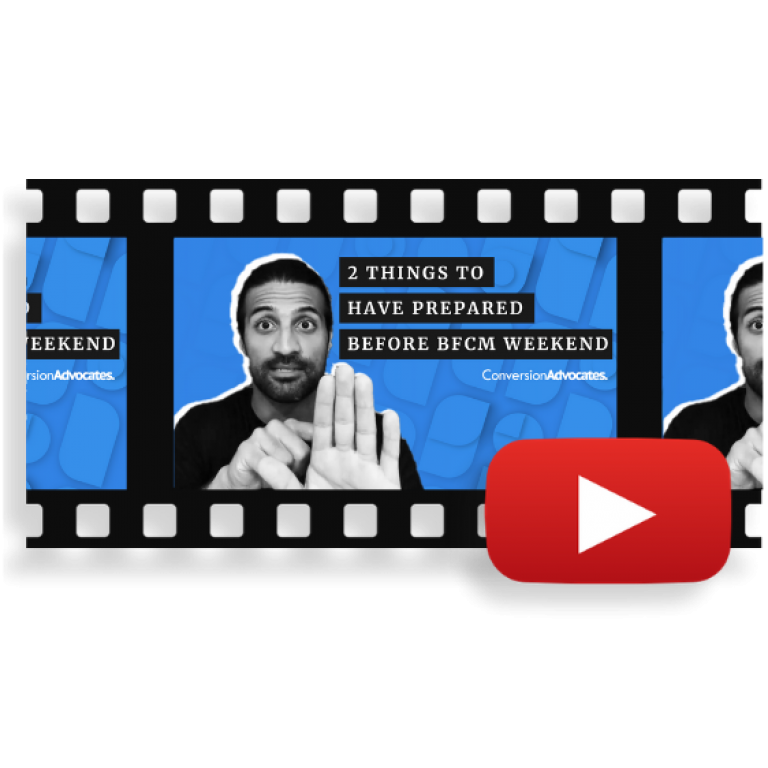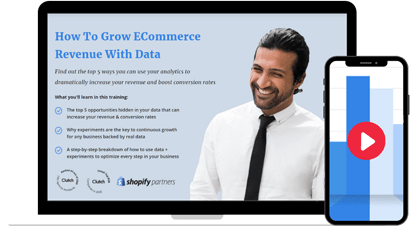a 5-minute read
You have probably been preparing for Black Friday and Cyber Monday for a while now. You’ve planned out and prepared campaigns, promotions, and marketing materials. But, before we dive into two Black Friday conversion rate optimization hacks that you have to do, let’s see this:
- Have you come up with a plan for what you’ll do after the biggest e-comm sale is done?
- Do you know how you’ll go about collecting valuable information during BFCM days?
- Will you be able to use those amazing results to your advantage in the upcoming Christmas sale season?
- Did you make sure your analytics is set-up correctly?
We’re here to help you make much more out of these (in)famous e-commerce days. If you pay close attention to the following two things, you will be thanking yourself so much after the BFCM weekend. Self-appreciation aside – these two things will give you a lot of ammunition for the Christmas sales cycle.
STEP 1 | Set up Your Data and Analytics Correctly Before Black Friday and Cyber Monday Start
Black Friday and Cyber Monday are synonyms for heavily investing in marketing and advertising. But since these activities will (hopefully) result in an increase in traffic, you’ll want to make sure your data and analytics are set up correctly. Why?
Because you’ll want to capture as much information about your visitors as possible.
As with everything in life, you’ll have two options:
- You’ll enjoy a spike in traffic, celebrate it with your colleagues, and, come Christmas season, cry yourself to sleep when the competition beats you
- You’ll celebrate BFCM success with your colleagues and then dig deep into collected data and uncover opportunities for optimization that will:
- Improve user experience
- Enhance your campaign performance
- Reduce bounce rate
- Increase conversion rates
- Capture more subscribers
- Amplify lifetime value of your existing customers
thus allowing you to make an even greater success in the Christmas seasons and all months to follow.
Don’t waste this golden opportunity. Choose option 2 and make sure your data and analytics are set up correctly. Then move on to the next step.
STEP 2 | Make an Experiment Plan for Black Friday and Cyber Monday
If you’re reading this, it means you’ve opted for the second option, and we salute you for it. Now let’s try to clarify how you’ll reach that point where your e-commerce business flourishes.
The answer is pretty simple.
Run tests.
Run scientific, business experiments on:
- Online shop
- Ad Campaigns
- Customer buying journey
- Landing Pages
- Product Pages
- Basically, on every touch-point your customer reaches
Yes, you’re already collecting significant amounts of data as is, but this is “passive data”. You didn’t have any (or very little) influence on it. It just happened! The data that comes from running experiments is comparative “actionable data”. And this type of data will help you optimize and grow your business at an exponential rate.
How to Create an Experiment Plan
Creating an experiment plan relies heavily on creating a customer experience hypothesis. Once you’ve brainstormed the hypothesis of what different segments of your customers are thinking as they interact and engage with your company and brand, you’ll be ready to create a plan of split-testing that will change your business for good.
We’ve prepared a list of questions that will help you outline your experiment plan:
- What are you trying to learn?
- What is the expected outcome?
- What will you do with the data after the experiment?
- How will you transform gathered information into business intelligence?
- How will you leverage this information to improve your e-commerce business even further?
Our advice would be to run experiments in three areas that can affect your business the most:
- User Experience
- Ad Campaigns
- Customer Buying Journey
Three Main Areas for Running Experiments During the Black Friday and Cyber Monday
Experiment Area 1 | User Experience
This is an experiment reserved exclusively for your:
- online shop,
- product pages,
- landing pages,
- sales pages,
- check-out,
- category pages.
Schedule a brainstorm Zoom session with your team and come up with some opportunities for testing.
Our suggestion would be to split-test different concepts, page layouts, messaging, calls-to-action. All of these things will help you uncover valuable information about your customers. They will answer questions like:
- Who are your actual customers?
- How do they make buying decisions?
- What touch-point is a game-changer for them?
If you’ve done the first step right (set up your data and analytics correctly), you’ll be able to dig in and segment each one of these variations. In return, insights like whether something is performing better on a mobile device or desktop, is paid advertising or organic promotion bringing better leads, etc., will help you optimize everything for the future sales.
Experiment Area 2 | Ad Campaigns
Split-testing ad campaigns is always a lot of fun, but during Black Friday and Cyber Monday it gets even better! The very nature of these two sales allows you to go crazy with your creatives and messaging, and the fact that customers are already prepared to buy – you know you’ll have at least a great ROAS (if not ROI) which gives you safe grounds to play more than usual.
Use this amazing opportunity to experiment with different messaging, creatives, targeting. This will help you find out how user/buyer/shopping behaviour changes based on these different variations.
Experiment Area 3 | Customer Buying Journey
Your online shop, landing pages, product pages, ads, etc., are all just one touch-points in your customer’s overall experience and buying journey. You’ll want to segment your customers and take them on different journeys based on their actions.
Our recommendation is the post-purchase experience.
Usually, when customers complete a purchase you send them all to the same post-purchase experience. You probably send them a thank you email, an invitation to subscribe to an exclusive newsletter, a polite request to leave you a review.
But what if you didn’t send them all down the same pipeline? What if you segment them based on their past behaviour and offer them something more specific? This way you could discover if this action will improve:
- Repeat purchases
- Number of reviews
- Visits to your online shop/website
Some Final Thoughts on Black Friday Conversion Rate Optimization
Experiments are an opportunity for you to learn new things, uncover new data that will help you enhance your business’ performance. Without them, you’ll be able to analyze only the “passive data” – the data you didn’t have any influence on. The data that happened on its own.
Creating variations results in comparative data. It lets you compare what IS with what COULD BE. This is why step 1, setting up your data and analytics correctly, is crucial for running experiments. You can’t do the latter without making sure you’ll capture the information correctly.
So if you made a decision to cross over to the side of active game-changers, we’ll be more than happy to guide you on this way. Make sure you use our special offer and schedule a FREE “BFCM Consultation Session” with our main business intelligence consultant.



